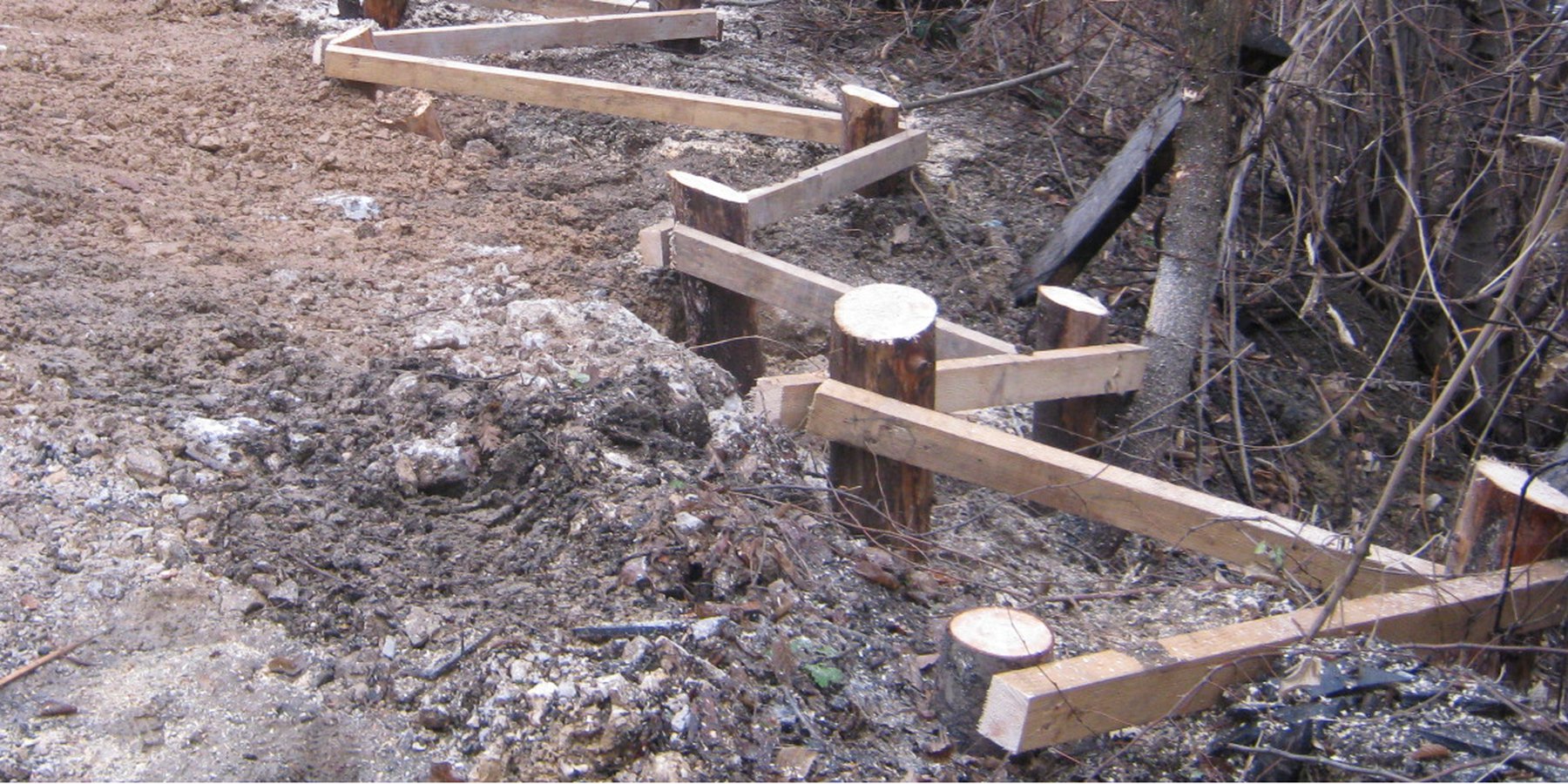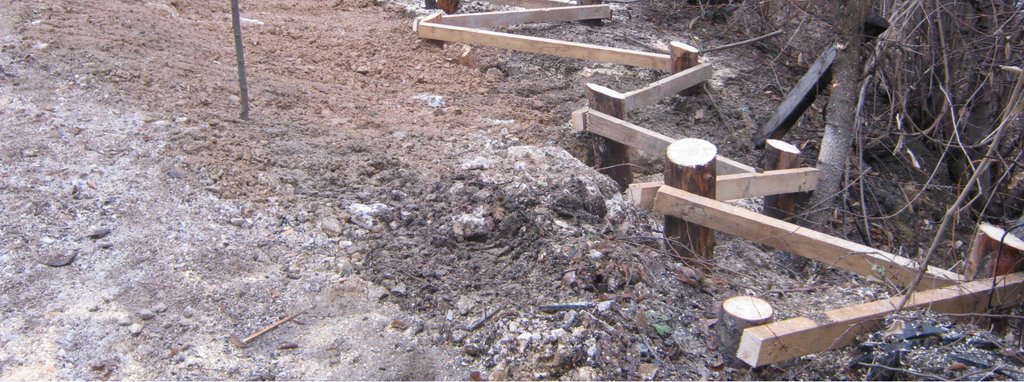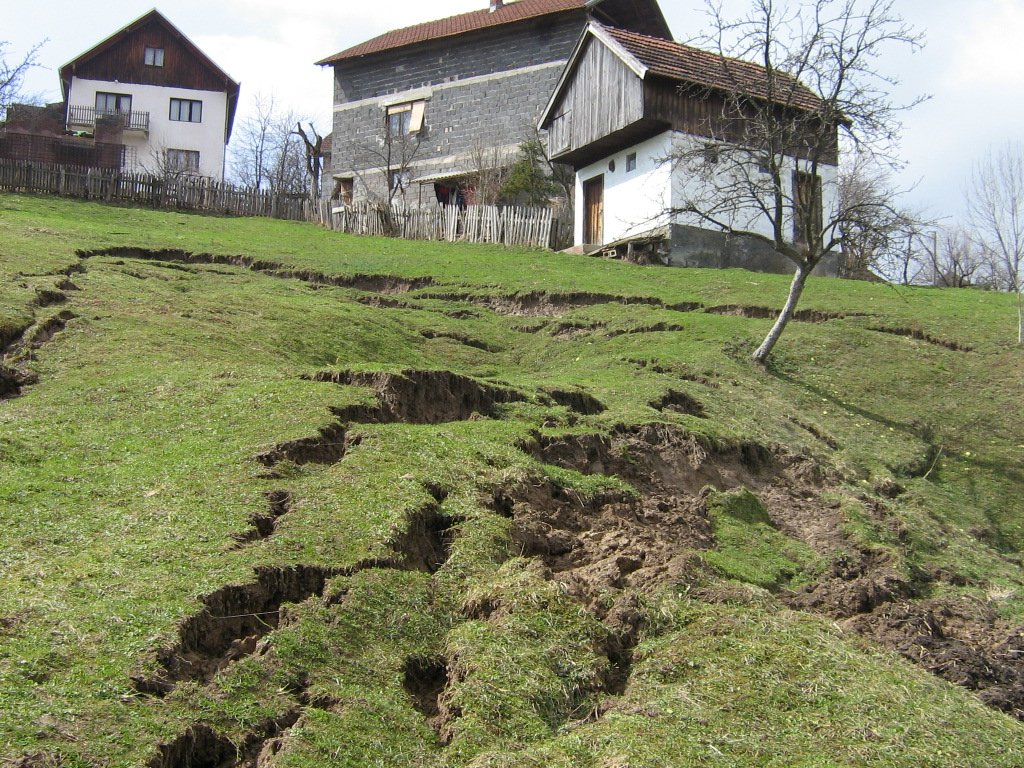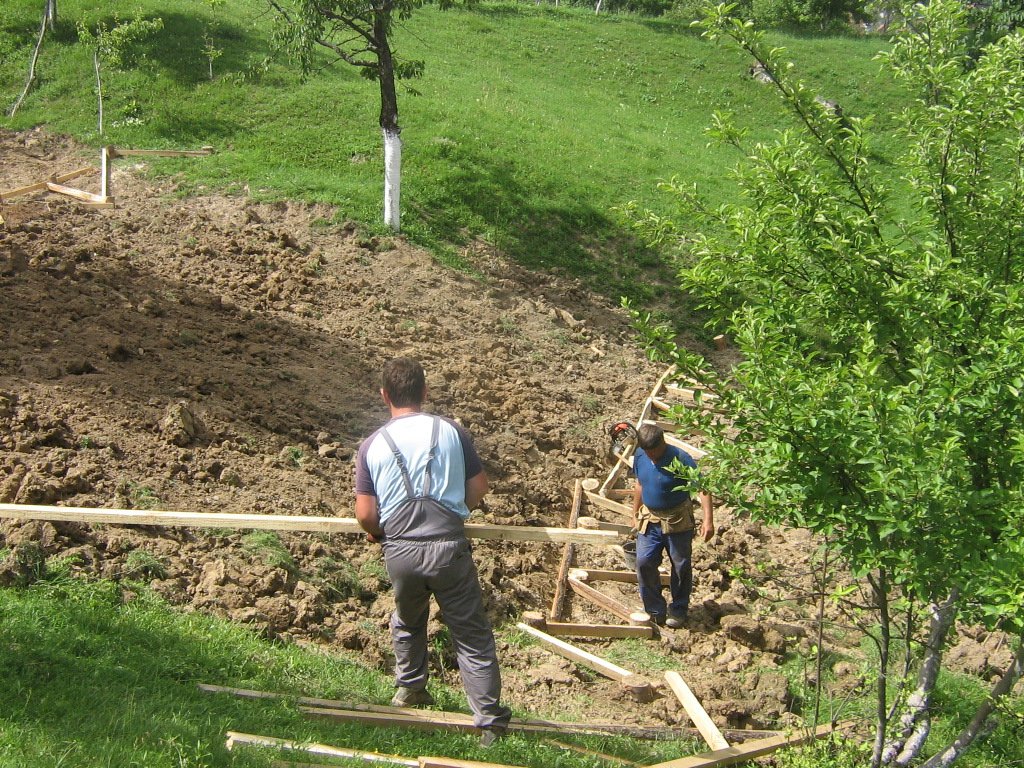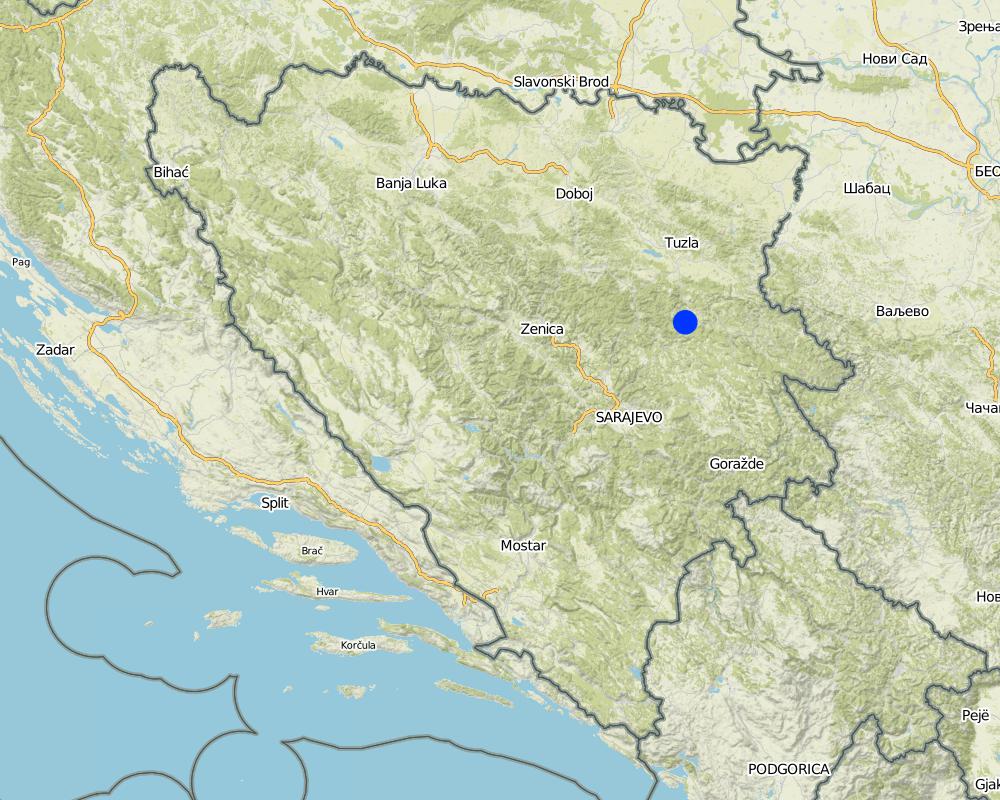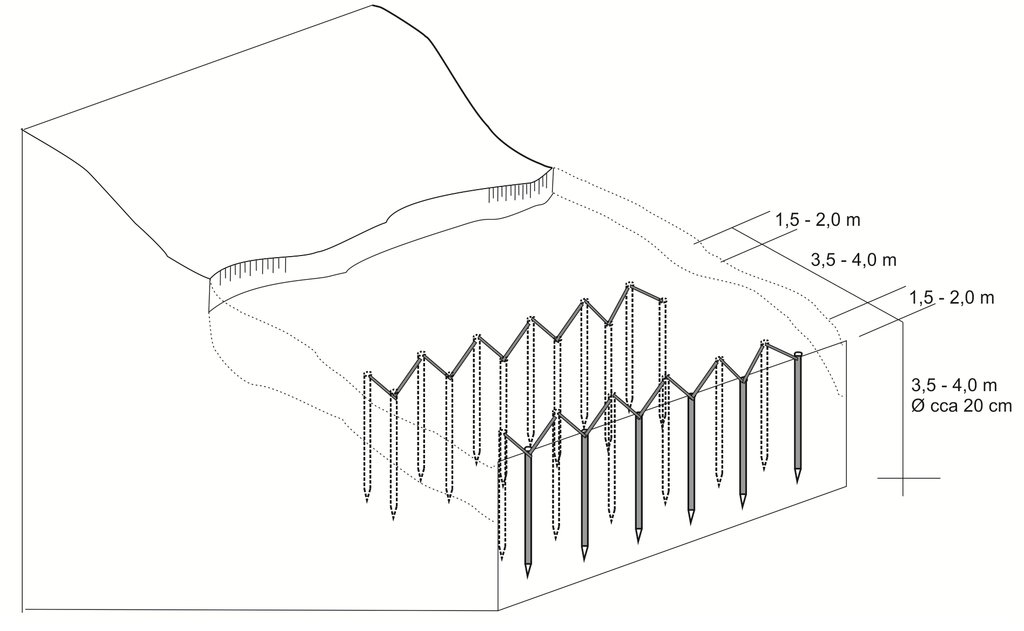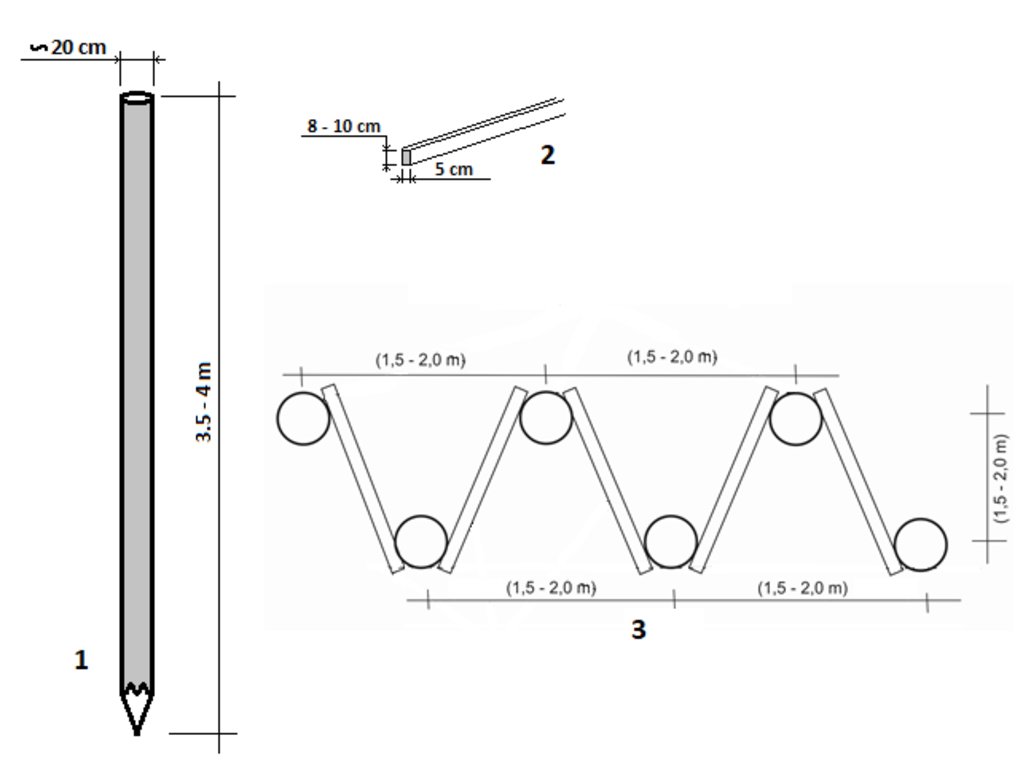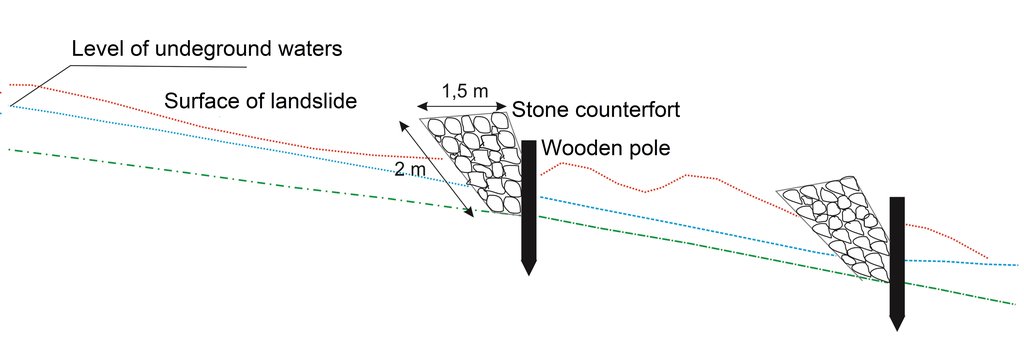Addressing shallow landslides by using wooden pole structures. [Bosnia and Herzegovina]
- Creation:
- Update:
- Compiler: Milenko Blesić
- Editor: –
- Reviewers: THEODORA FETSI, Rima Mekdaschi Studer, Donia Mühlematter
Zaustavljanje plitkih klizišta drvenim šipovima
technologies_4285 - Bosnia and Herzegovina
View sections
Expand all Collapse all1. General information
1.2 Contact details of resource persons and institutions involved in the assessment and documentation of the Technology
SLM specialist:
SLM specialist:
Čustović Hamid
University of Sarajevo, Faculty of Agriculture and Food Sciences
Bosnia and Herzegovina
SLM specialist:
Bajrić Muhamed
University of Sarajevo, Faculty of Forestry
Bosnia and Herzegovina
Municipality Kladanj Agronomist:
Hajdarević Hajda
Department of Finance, Entrepreneurship and Local Economic Development, Municipality of Kladanj
Bosnia and Herzegovina
land user:
Hotović Huso
Land user, Borak Locality, Kladanj Municipality
Bosnia and Herzegovina
1.3 Conditions regarding the use of data documented through WOCAT
The compiler and key resource person(s) accept the conditions regarding the use of data documented through WOCAT:
Yes
1.4 Declaration on sustainability of the described Technology
Is the Technology described here problematic with regard to land degradation, so that it cannot be declared a sustainable land management technology?
No
2. Description of the SLM Technology
2.1 Short description of the Technology
Definition of the Technology:
Utilization of wooden pole structures placed in parallel, to reduce shallow landslides (2-3 m) in relatively small surfaces. Possibility to be combined with drainage system for better results.
2.2 Detailed description of the Technology
Description:
Farmers in northeast parts of Bosnia and Herzegovina traditionally applied the technology to address shallow landslides, surface erosion or loss of top soil due to sheet or interrill erosion. Movements of the upper layers of the soil appears due to unfavorable properties of the soil layers (clays, pseudoclays), set on impermeable geological substrates, all under conditions of intense and long-term rainfall. During the last decades, it has been frequently applied in the area of Kladanj municipality, whose administrative services for agriculture and forestry technically specified and promoted the technology. Landslides are one of the major problems in the hilly areas of Bosnia and Herzegovina, threatening particularly the agricultural lands. The technology is being applied by farmers on their own properties, but it is also part of public interventions, e.g. for the protection of roads or other infrastructure from landslides or in the context of roads recovery programs damaged by landslides. The technology aims to reduce the impact of the shallow (up to 2 - 3 m in depth) landslides of relatively small surface, by preventing further movement of the soil. So far, it is sporadically applied on around 20 – 30 locations in Kladanj Municipality, whose territory is around 355 sq. kilometers.
The technology implies pounding wooden poles in front (below) of the frontline of the landslide, along the contour, perpendicular to the slope. Land users recommend oaken pols due to their durability. The poles are usually 3.5 – 4 m long and 20 – 30 cm in diameter. One pole formation consists of two parallel lines of poles, with 1.5 to 2 m distance from line to line. The poles are positioned in a staggered way that a zigzag is formed. The poles are interconnected with wooden laths. One pole formation is usually enough to address smaller landslides, but in case of larger landslides, two formations are recommended. In the latter case, in combination with a drainage system, stone counterforts are formed in front (above) the poles' formation. See technical drawing for more details.
The primary purpose of the technology is to recover shallow and small landslides on slopping terrains. Stopping the movement of agricultural land after reparation of cracks and land gaps caused by landfall enables re-utilization of the land for either agricultural production or agro-forestry. In the municipality of Kladanj walnuts or other wooden fruit species with strong roots are often planted on recovered landslides.
After a prior assessment of the depth and surface of the landslide, an expert or a technician prepares simple project sketches. The sketches define configuration of pole formations and materials needed for the construction (oak poles, laths). The realization of the technology is not particularly demanding. Nowadays machines are used to pound poles in the ground (mainly by a dredge's spoon).
It is a relatively inexpensive technology which could be financed by even small farmers who can protect or recover their, under Bosnia and Herzegovina conditions, usually small agricultural land parcels.
Although not an integral part of the technology, modification with water drainage from the body of bigger landslide ensures additional, long lasting stability of the terrain. If performed, the drainage is carried out by depositing drainage material (perforated pipes, pebbles, tiny stone fractions) in the lower zone of drainage trenches whose configuration and depth depends on the terrain conditions. Another modification of the technology could include construction of a stone counterfort in front (above) the pole formation. These modifications are briefly presented in the technical specification of the technology, but they were not applied on the site (Borak locality) where activities, establishment and maintenance costs of the technology were observed.
2.3 Photos of the Technology
2.5 Country/ region/ locations where the Technology has been applied and which are covered by this assessment
Country:
Bosnia and Herzegovina
Region/ State/ Province:
Tuzla canton
Further specification of location:
Kladanj municipality
Specify the spread of the Technology:
- applied at specific points/ concentrated on a small area
Is/are the technology site(s) located in a permanently protected area?
No
Map
×2.6 Date of implementation
If precise year is not known, indicate approximate date:
- 10-50 years ago
2.7 Introduction of the Technology
Specify how the Technology was introduced:
- as part of a traditional system (> 50 years)
3. Classification of the SLM Technology
3.1 Main purpose(s) of the Technology
- reduce, prevent, restore land degradation
- reduce risk of disasters
3.2 Current land use type(s) where the Technology is applied
Land use mixed within the same land unit:
No

Cropland
- Annual cropping
- Tree and shrub cropping
Annual cropping - Specify crops:
- cereals - maize
- cereals - other
- fodder crops - alfalfa
- fodder crops - other
- vegetables - other
- Apples, Plums, Pears, Berry fruits
Number of growing seasons per year:
- 1
Is intercropping practiced?
Yes
If yes, specify which crops are intercropped:
Vegetables in orchards

Grazing land
Extensive grazing:
- Ranching
Intensive grazing/ fodder production:
- Improved pastures
Animal type:
- cattle - dairy
- cattle - non-dairy beef
- sheep
Is integrated crop-livestock management practiced?
No
Products and services:
- meat
- milk

Settlements, infrastructure
- Traffic: roads, railways
Comments:
The technology could be applied on various types of land use. In the northeast region of Bosnia and Herzegovina it is commonly applied on: grazing land, cropland (annual, perennial, trees and shrubs), and mixed land uses. In Kladanj municipality the technology is frequently applied for protection or reconstruction of roads damaged by landslides.
3.3 Has land use changed due to the implementation of the Technology?
Has land use changed due to the implementation of the Technology?
- No (Continue with question 3.4)
Land use mixed within the same land unit:
No
3.4 Water supply
Water supply for the land on which the Technology is applied:
- rainfed
3.5 SLM group to which the Technology belongs
- cross-slope measure
- stopping landslides, recovery of landslides
3.6 SLM measures comprising the Technology

structural measures
- S3: Graded ditches, channels, waterways
- S6: Walls, barriers, palisades, fences
3.7 Main types of land degradation addressed by the Technology

soil erosion by water
- Wm: mass movements/ landslides
3.8 Prevention, reduction, or restoration of land degradation
Specify the goal of the Technology with regard to land degradation:
- reduce land degradation
- restore/ rehabilitate severely degraded land
4. Technical specifications, implementation activities, inputs, and costs
4.1 Technical drawing of the Technology
Technical specifications (related to technical drawing):
The sketch depicts the cross-section of the terrain, illustrating the wooden poles’ structures and the technical characteristics of the technology. Two wooden structures are being placed in parallel, at a distance of 3.5-4 m. Each structure is consisted by wooden poles positioned in a zigzag form. The poles are pounded in the ground at a depth of 3.5 m and are connected to each other with wooden laths. The distance between the poles is 1.5-2 m. The number of poles to be used, depends on the size of the area where the intervention is needed. The recommended distance between the two parallel structures is 3 – 4 m, depending on the characteristics of the terrain.
The implementation of the technology does not bring any change on the slope and could be applied on various slopes. The technology is mostly applied on agricultural or infrastructural land, i.e. on slopes not above 30%.
Author:
Muhamed Bajrić, Milenko Blesić
Date:
20/10/2018
Technical specifications (related to technical drawing):
Drawing 1 shows the recommended dimensions of the poles.Drawing 2 illustrates the technical characteristics of the laths (2) which connect the poles. Drawing 3 shows the top view of the overall structure with the required dimensions.
Author:
Milenko Blesić, Muhamed Bajrić
Date:
20/10/2018
Technical specifications (related to technical drawing):
Modification (improvement) of the technology with a drainage system. The modification (drainage) was not applied on the site where the technology was observed.
Author:
Muhamed Bajrić
Date:
10/11/2018
Technical specifications (related to technical drawing):
Modification (improvement) of the technology by construction of the stone counterforts just above the line of poles. The modification (stone counterforts) was not applied on the site where the technology was observed.
Author:
Muhamed Bajrić
Date:
10/11/2018
4.2 General information regarding the calculation of inputs and costs
Specify how costs and inputs were calculated:
- per Technology unit
Specify unit:
Landslide on Borak locality - Kladanj municipalitay
Specify dimensions of unit (if relevant):
0,35 ha
Specify currency used for cost calculations:
- USD
Indicate average wage cost of hired labour per day:
29.24 USD
4.3 Establishment activities
| Activity | Timing (season) | |
|---|---|---|
| 1. | Expert's characterization of landslide | Any time |
| 2. | Designing the structure and identifying the materials | Any time |
| 3. | Purchase and transport of materials (poles, laths) | Any time |
| 4. | Pounding poles in the ground | Spring - autumn |
| 5. | Connection of poles' heads (above ground parts) with laths | Spring - autumn |
| 6. | Machine leveling of the terrain | Spring - autumn |
| 7. | Planting of walnut seedlings | Autumn |
Comments:
Establishment activities are presented in accordance withe the activities on one specific (Borak) locality. The surface of landslide on this locality was around 0,35 ha, and after its stopping with the formation of wooden poles, its full recovery was done by leveling of the terrain and planting of 300 walnut seedlings (further walnut orchard). The list of final recovery activities could be different on other localities and it depends of landowners' intentions and financial possibilities.
4.4 Costs and inputs needed for establishment
| Specify input | Unit | Quantity | Costs per Unit | Total costs per input | % of costs borne by land users | |
|---|---|---|---|---|---|---|
| Labour | Expert's characterization of landslide, designing of construction, specification of materials | Working day | 2.0 | 100.0 | 200.0 | 100.0 |
| Labour | Pounding the poles into the ground | Working day | 10.0 | 29.24 | 292.4 | 100.0 |
| Labour | Connecting poles with lathes | Working day | 1.0 | 29.24 | 29.24 | 100.0 |
| Labour | Planting of walnut seedlings | Working day | 10.0 | 29.24 | 292.4 | 100.0 |
| Equipment | Heavy machinery (dredge) work on pounding poles into the ground (hired) | Hour | 16.0 | 46.78 | 748.48 | 30.0 |
| Equipment | Heavy machinery (dredge) work on leveling of terrain | Hour | 4.0 | 46.78 | 187.12 | 30.0 |
| Plant material | Walnut seedlings | Piece | 300.0 | 2.92 | 876.0 | 30.0 |
| Construction material | Wooden (oak) poles | Piece | 100.0 | 17.5 | 1750.0 | 30.0 |
| Construction material | Wooden connecting laths | m | 200.0 | 0.5 | 100.0 | 30.0 |
| Construction material | Other auxiliary materials (nails, wire, etc.) | Lump sum | 1.0 | 12.0 | 12.0 | 100.0 |
| Total costs for establishment of the Technology | 4487.64 | |||||
| Total costs for establishment of the Technology in USD | 4487.64 | |||||
If land user bore less than 100% of costs, indicate who covered the remaining costs:
So far, introduction of the technology in Kladanj municipality is supported from the municipality's budget (contribution in purchase of materials and hiring of heavy machinery).
Comments:
The presented activities and costs are related to the landslide (0,35 ha) on Borak (Kladanj municipality) locality. On this particular site, the technology is applied without drainage system and stone counterforts next to wooden pole lines. Though they are not linearly connected, costs on other sites may be smaller or higher, depending on the size of landslides and concrete conditions on the ground.
4.5 Maintenance/ recurrent activities
Comments:
After establishment, the technology does not need any particular maintenance activities.
4.6 Costs and inputs needed for maintenance/ recurrent activities (per year)
Comments:
Due to the fact that after establishment the technology does not need any major maintenance activities, there are not any significant costs for maintenance. The maintenance is limited to annual checking of joints between lathes and poles and necessary minor interventions (replacement of possibly damaged lathes, re-connection of laths).
4.7 Most important factors affecting the costs
Describe the most determinate factors affecting the costs:
Prices of the construction materials (poles, laths).
Hiring costs of heavy machinery (dredge).
5. Natural and human environment
5.1 Climate
Annual rainfall
- < 250 mm
- 251-500 mm
- 501-750 mm
- 751-1,000 mm
- 1,001-1,500 mm
- 1,501-2,000 mm
- 2,001-3,000 mm
- 3,001-4,000 mm
- > 4,000 mm
Specify average annual rainfall (if known), in mm:
894.00
Specifications/ comments on rainfall:
The highest precipitations appear during spring and early summer, (June 111 L/m2; February 55 L/m2). Heavy downpours during summer is one of the climatic features of this area.
Indicate the name of the reference meteorological station considered:
Tuzla
Agro-climatic zone
- sub-humid
5.2 Topography
Slopes on average:
- flat (0-2%)
- gentle (3-5%)
- moderate (6-10%)
- rolling (11-15%)
- hilly (16-30%)
- steep (31-60%)
- very steep (>60%)
Landforms:
- plateau/plains
- ridges
- mountain slopes
- hill slopes
- footslopes
- valley floors
Altitudinal zone:
- 0-100 m a.s.l.
- 101-500 m a.s.l.
- 501-1,000 m a.s.l.
- 1,001-1,500 m a.s.l.
- 1,501-2,000 m a.s.l.
- 2,001-2,500 m a.s.l.
- 2,501-3,000 m a.s.l.
- 3,001-4,000 m a.s.l.
- > 4,000 m a.s.l.
Indicate if the Technology is specifically applied in:
- not relevant
5.3 Soils
Soil depth on average:
- very shallow (0-20 cm)
- shallow (21-50 cm)
- moderately deep (51-80 cm)
- deep (81-120 cm)
- very deep (> 120 cm)
Soil texture (topsoil):
- medium (loamy, silty)
Soil texture (> 20 cm below surface):
- fine/ heavy (clay)
Topsoil organic matter:
- medium (1-3%)
5.4 Water availability and quality
Ground water table:
on surface
Availability of surface water:
medium
Water quality (untreated):
for agricultural use only (irrigation)
Water quality refers to:
surface water
Is water salinity a problem?
No
Is flooding of the area occurring?
Yes
Regularity:
episodically
5.5 Biodiversity
Species diversity:
- medium
Habitat diversity:
- medium
5.6 Characteristics of land users applying the Technology
Sedentary or nomadic:
- Sedentary
Market orientation of production system:
- mixed (subsistence/ commercial)
Off-farm income:
- > 50% of all income
Relative level of wealth:
- average
Individuals or groups:
- individual/ household
Level of mechanization:
- manual work
- mechanized/ motorized
Gender:
- men
Age of land users:
- middle-aged
5.7 Average area of land used by land users applying the Technology
- < 0.5 ha
- 0.5-1 ha
- 1-2 ha
- 2-5 ha
- 5-15 ha
- 15-50 ha
- 50-100 ha
- 100-500 ha
- 500-1,000 ha
- 1,000-10,000 ha
- > 10,000 ha
Is this considered small-, medium- or large-scale (referring to local context)?
- medium-scale
5.8 Land ownership, land use rights, and water use rights
Land ownership:
- individual, titled
Land use rights:
- individual
Water use rights:
- open access (unorganized)
Are land use rights based on a traditional legal system?
Yes
5.9 Access to services and infrastructure
health:
- poor
- moderate
- good
education:
- poor
- moderate
- good
technical assistance:
- poor
- moderate
- good
employment (e.g. off-farm):
- poor
- moderate
- good
markets:
- poor
- moderate
- good
energy:
- poor
- moderate
- good
roads and transport:
- poor
- moderate
- good
drinking water and sanitation:
- poor
- moderate
- good
financial services:
- poor
- moderate
- good
6. Impacts and concluding statements
6.1 On-site impacts the Technology has shown
Socio-economic impacts
Income and costs
farm income
diversity of income sources
Ecological impacts
Soil
soil loss
Climate and disaster risk reduction
landslides/ debris flows
6.2 Off-site impacts the Technology has shown
downstream flooding
downstream siltation
damage on neighbours' fields
damage on public/ private infrastructure
6.3 Exposure and sensitivity of the Technology to gradual climate change and climate-related extremes/ disasters (as perceived by land users)
Gradual climate change
Gradual climate change
| Season | increase or decrease | How does the Technology cope with it? | |
|---|---|---|---|
| annual temperature | increase | well | |
| seasonal temperature | summer | increase | well |
| seasonal rainfall | summer | decrease | well |
Climate-related extremes (disasters)
Meteorological disasters
| How does the Technology cope with it? | |
|---|---|
| local rainstorm | well |
Hydrological disasters
| How does the Technology cope with it? | |
|---|---|
| flash flood | very well |
6.4 Cost-benefit analysis
How do the benefits compare with the establishment costs (from land users’ perspective)?
Short-term returns:
slightly negative
Long-term returns:
positive
How do the benefits compare with the maintenance/ recurrent costs (from land users' perspective)?
Short-term returns:
positive
Long-term returns:
very positive
6.5 Adoption of the Technology
- 1-10%
If available, quantify (no. of households and/ or area covered):
According to information from Kladanj municipality administration, on the municipality territory there are around 30 localities with the applied technology.
Of all those who have adopted the Technology, how many did so spontaneously, i.e. without receiving any material incentives/ payments?
- 0-10%
Comments:
Most of the interventions on private properties were partly supported by specific municipal/cantonal programs for recovery of lands, damaged by heavy rains, flash floods and landslides. All interventions on infrastructure (mainly roads) were fully supported by municipal/cantonal budgets.
6.6 Adaptation
Has the Technology been modified recently to adapt to changing conditions?
Yes
other (specify):
Improvemnts of the technology effects and durability
Specify adaptation of the Technology (design, material/ species, etc.):
The original technology (wooden poles barriers) has been recently modified by parallel installment of drainage of landslide, and most recently by stone enforcement just above the line of wooden poles.
6.7 Strengths/ advantages/ opportunities of the Technology
| Strengths/ advantages/ opportunities in the land user’s view |
|---|
| Relatively affordable way to stop and recover landslides on agricultural land |
| Wide availability of construction material (wood) in the region |
| Strengths/ advantages/ opportunities in the compiler’s or other key resource person’s view |
|---|
| Costly effective way to recover agricultural land on small private parcels (usual in Bosnia and Herzegovina) endangered by landslides |
| The technology keeps land from further degradation or possible loss of soil and allows continuation of its current or different functional use |
6.8 Weaknesses/ disadvantages/ risks of the Technology and ways of overcoming them
| Weaknesses/ disadvantages/ risks in the land user’s view | How can they be overcome? |
|---|---|
| It is not always easy to find/hire heavy mechanization for pounding of poles into the ground | Organization of farmers who want to introduce the technology and request for municipality support in hiring heavy machinery |
| Weaknesses/ disadvantages/ risks in the compiler’s or other key resource person’s view | How can they be overcome? |
|---|---|
| Limited durability of the wooden poles. | |
| The technology itself (i.e. without extensive drainage) is not efficient in stopping and recovering larger and deep landslides | Added investment in properly projected and implemented drainage system |
7. References and links
7.1 Methods/ sources of information
- field visits, field surveys
Field surveys from May to December 2018, valuable information from Ms Hajda Hajdarević, Kladanj municipality's office for agriculture.
- interviews with land users
During filed surveys five land users who applied the technology were interviewed.
- interviews with SLM specialists/ experts
Besides field surveys, precious information regarding the landslide issues and possible technology effects were provided by professors Hamid Čustović and Muhamed Bajrić (University of Sarajevo).
Comments:
Field data compilation was done through six field surveys performed between May and December 2018.
Links and modules
Expand all Collapse allLinks
No links
Modules
No modules


